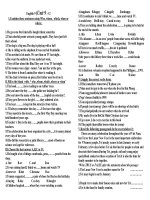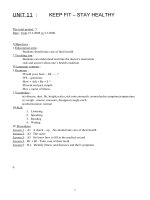- Trang chủ >>
- Sư phạm >>
- Sư phạm vật lý
unit 2
Bạn đang xem bản rút gọn của tài liệu. Xem và tải ngay bản đầy đủ của tài liệu tại đây (195.69 KB, 21 trang )
<span class='text_page_counter'>(1)</span>UNIT 2. CLOTHING. DIVISION OF LESSON Lesson 1 Period 7 2 8 3 9 4 10 5 11. Getting started – listen and read Speak + Listen Read Write Language focus. ************************************ Week: 5 Unit: 2 CLOTHING Period: 7 Lesson :1 GETTING STARTED- LISTEN AND READ Page 13-14 Date: 10 /9/12 I. Aims: - By the end of the lesson, students will be able to know more some about Ao dai, the traditional dress of Vietnamese women. II. Language contents: 1. Grammar: Review: Present perfect tense: Has/ Have + p.p 2. Vocabulary: (n) poet / poem long silk tunic writer/ novel loose pant musician ethnic minorities inspiration traditional design III. Techniques: - Quiz, answer true or false statements, ask and answer the questions, gap fill. IV. Teaching aids: V. Procedures: Teacher’s and students’ activities Teacher has students write the structure “ wish” and then make two sentences with it. Teacher corrects and gives marks to students. Teacher has students look at the photo pictures and presents new words. Teacher guides students to read new. Contents 10 marks( 5 minutes ) S + wish(es) + S + be(were) V2/ V-ed Students answer 1. Warm up:( 7 minutes) Kimono(n) đồ kimônô, áo đầm của Nhật Kilt(n) váy ( người miền núi) Sari(n) đồ xari ( trang phục người Ấn).
<span class='text_page_counter'>(2)</span> words chorally and individually. Teacher guides students practice in pairs.. Teacher presents the lesson and new words. Teacher guides students to read new words in chorally and individually.. Veil(n) khăn che mặt Quiz Example: T: where does the woman in the picture a come from? S1: She comes from Japan. T: Why do you know she comes from Japan? S1: Because she is wearing a Kimono. Answers a. She comes from Japan. b. She comes from Vietnam. c. He comes from Scotland. …………. 2. Presentation:( 8 minutes) New words: Long silk tunic(n) áo lụa dài rộng Poet(n) nhà thơ Writer(n) nhà văn Novel(n) tiểu thuyết Musician(n) nhạc sĩ Ethnic minorities(n) dân tộc tiểu số Pattern(n) mẫu vẽ Stripe(n) sọc What and where( 10 marks ) Pattern. Teacher checks students’ vocabulary by “what and where”. Stripe. musicia n. Teacher corrects and gives marks to students.. Teacher sets the scene “ you are going to read a text about the traditional dress of Vietnam”. Teacher has students look at the statements, listen to the tape twice and guess them which are true or false statements.. Novel. poet. Answer true or false statements 1.The ao dai is the traditional dress of Vietnamese women. 2. The design and material used for men were not different from those used for women. 3. Nowadays it is usually worn by Vietnamese women on special occasions. 4 Traditional designs and symbols such as suns, starts, crosses, and stripes have been added to the ao dai. 3. Practice: ( 15 minutes) Answers.
<span class='text_page_counter'>(3)</span> 1T Teacher has students open their books and check their answers. Teacher corrects their mistakes. Teacher has students read the text and do exercise a on the page 14. Teacher corrects their mistakes.. Teacher has students read the text again,and then answer the questions in pairs. Teacher corrects the mistakes.. Teacher has students tell what they have known about the ao dai. Teacher corrects and gives marks to encourage students.. 2F. 3T. 4T. a/. 1 .……. Poems, novel and songs 2 ……..long silk with slits up the sides worn over loose pants 3 ……..to wear modern clothing at work 4 ……..printing lines of poetry on it 5 ……..symbols such as suns, starts, crosses and stripes b/. 1. Traditionally, men and women used to wear the ao dai. 2. Because it is more convenient. 3. they have printed lines of poetry on it or have added symbols such as suns, starts, crosses and stripes to the ao dai. 4. Production:( 5 minutes) Speaking (10 marks) The ao dai is the traditional dress of Vietnamese. Traditionally, men and women used to wear it. But today, the majority of Vietnamese women prefer to wear modern clothing at work. Because it is convenient………… 5.Homework:( 3 minutes) Learn by heart new words. Practice the text again. Do exercises 1,2/ page 12-13 Prepare: Unit 2 Speak+ listen / page 14-15-16 Find out new words Review simple present. * Comments: Class. 9A1: 9A2:. * Ưu điểm: Nội dung: …………………………………………………………………………………… Phương pháp: ……………………………………………………………………………… Đddh: ……………………………………………………………………………………… * Khuyết điểm Nội dung: ……………………………………………………………………………………. Phương pháp: ……………………………………………………………………………… Đddh: ………………………………………………………………………………………. Hướng khắc phục:.
<span class='text_page_counter'>(4)</span> ………………………………………………………………………………………………… ………………………………………………………………………………………………….
<span class='text_page_counter'>(5)</span> Week: 5 Period: 8 Date: 10 /09/2012. Unit: 2 CLOTHING Lesson :2 SPEAK + LISTEN Page /14- 15 -16. I. Aims: By the end of the lesson, students will be able to ask and respond to questions on personal preferences. Listen for specific, describe what people are wearing. II. Language contents: 1. Grammar: Review: The present simple tense Wh- questions, yes/ no question 2.Vocabulary: a colorful T-shirt a short-sleeved baggy pants comfortable a paid skirt a sleeveless faded jeans fashionable a plain suit a striped shirt blue shorts (n) sandals, announcement, floral pants, polka dot, entrance III. Techniques: Survey, hangman, picture drill. IV. Teaching aids: photo pictures V. Procedures: Teacher’s and students’ activities Teacher guides students to play the game “hangman”.. then T asks Ss some questions. Content 1.Warm up:( 3 minutes) Hangman: __ __ __ __ __ __ __ __ CLOTHING 1. What clothing do women in Viet nam often wear at Tet or special occasions? Ao dai 2. Why do they often wear it? Because Ao dai is a traditional clothing in Viet nam. Teacher sets the scene “In the last lesson, Speak we got some information about ao dai – the 2.Pre speaking:( 7 minutes ) traditional dress of Vietnam. Today we will a. learn about the casual clothes that we wear New words: daily”. A colorful T-shirt (n) áo thun nhiều màu A sleeveless sweater (n) áo len không tay Teacher presents the new words by the A short sleeved blouse (n) áo cánh ngắn tay.
<span class='text_page_counter'>(6)</span> photo pictures. Teacher guides students to read the new words chorally and individually.. Teacher checks students’ vocabulary by picture drill. Teacher explains the part b and has students practice in groups. ( 3 minutes ). A striped shirt (n) áo sơ mi sọc A plain suit (n) com lê trơn Faded jeans (n) quần gin bạc màu Blue shorts (n) quần sọt xanh A plaid skirt (n) váy carô Baggy pants (n) quần thụng Casual clothes (n) quần áo mặc thường Comfortable(adj) thoải mái Relaxed (adj) thư giãn Fashionable (adj) hợp thời trang Announcement (n) thông báo Entrance (n) gate Floral (adj) có hoa văn Polka dot skirt (n) váy có chấm tròn Sandals (n) giày xăng đan 3.While speaking: ( 10 minutes) b. Questions: a/ What do you usually wear on the weekend? b/ Why do you wear these clothes/ c/ What is your favorite type of clothing? Why? d/ Is it comfortable to wear uniform? e/ What type of clothing do you usually wear on the Tet holiday? f/ What would you wear to party? Ex: Mai said : “ I wear a T- shirt and blue shorts on the weekend”. Teacher calls each group to practice in front of the class. Teacher has students remind the reported speech.. Teacher corrects their mistakes.. Mai said that she wore a T- shirt and blue shorts on the weekend. c. Thao said she liked to wear faded jeans on the weekend because she felt very comfortable Thien said he wore baggy pants and a striped shirt. 4.Post speaking:(3 minutes) 10 marks: Change into the indirect speech a/ Mary said: “ John speaks English well.” b/ They said: “ Loan is a good student.” Answer: a/ Mary said that John spoke English well. b/ They said that Loan was a good student..
<span class='text_page_counter'>(7)</span> Teacher has students do the exercise individually. Teacher corrects and gives marks to encourage students. Teacher asks students some questions to present the lesson.. Teacher presents the clothing on the photo pictures.. Listen - Pre - listen -. Do you hear a public announcement when you visit a place? + Yes, I do/ No, I don’t - What are they? + A lost person + A lost document + A lost things ---------------------------. A floral pants B blue shorts C polka dot skirt b. A long sleeved white blouse B short sleeved pink blouse C short sleeved white blouse c. A blue sandal B red boots C brown shoes. . While listening: ( 18 minutes) Answer: a. B She’s wearing blue shorts b. A She’s wearing a long sleeved white blouse c. C She’s wearing brown shoes Teacher has students listen to the tape twice Tape transcript: and choose the correct photo pictures. On Public Announcement Teacher has students listen to the tape again Attention please. Here is a special and corrects the mistakes. announcement. A little girl is reported missing. She was last seen 20 minutes ago near the main entrance to the Car Fair. Her name Mary and she is 3 years old. She has short dark hair. She’s wearing shorts – blue shorts and a long- sleeved white blouse. She’s wearing a pair of shoes brown shoes. She may be carrying a large doll. If you see Mary, bring her to the Information Desk. Her father is waiting for her there. Thank you. 4. Post listening: (6 minutes) Speaking ( 10 marks) 1. How old is Mary? She is three..
<span class='text_page_counter'>(8)</span> Teacher has students retell some other information about Mary by answering the questions. (individually) Teacher corrects and gives marks to encourage students.. 2. Where was she last seen? She was last seen near a main entrance to the Car Fair. 3. What’s she like? She has short dark hair 5.Homework:( 3 minutes) Learn by heart new words. Review the reported speech. Practice speaking skill again. Prepare: Unit 2 Read / page 17- 18 Find out new words. Answer the question. * Comments: Class. 9A1: 9A2:. * Ưu điểm: Nội dung: …………………………………………………………………………………… Phương pháp: ……………………………………………………………………………… Đddh: ……………………………………………………………………………………… * Khuyết điểm Nội dung: ……………………………………………………………………………………. Phương pháp: ……………………………………………………………………………… Đddh: ………………………………………………………………………………………. Hướng khắc phục: ………………………………………………………………………………………………… …………………………………………………………………………………………………. Week:6 Period 9 Date:17/9/2012. UNIT 2 CLOTHING LESSON 4 READ P. 17 -18.
<span class='text_page_counter'>(9)</span> I. Aims : Students will be able to understand the text for details about jeans II. Language contents : 1. Vocabulary : (n)material, cotton, style, generation (v) wear out, embroider, label 2. Structure : Review: The past simple tense III. Techniques: net work,slap the board, group IV. Teaching aids : Extra board(exercises) IV. Procedure : Teacher’s and students’ activities Teacher has students describe about Mary.. T asks Ss some questions about Mary Teacher corrects and gives marks to students.. Teacher guides students to play “networks”. Content Revision (10 marks)( 4 minutes) Mary is three years old. She was last seen near the main entrance to the Car Fair. She has short dark hair. She’s wearing a long sleeved white blouse…… 1. What was she wearing when she missed? 2. Where was she last seen? * Keys: 1.She was wearing a long sleeved white blouse and blue shorts 2. She was last seen near the main entrance to the Car Fair 1.Warm up: (5 minutes) Networks:. Durable Fashionable. Easy to wear Jeans.
<span class='text_page_counter'>(10)</span> Teacher sets the scene “we have discussed about jeans. In today’s reading, we’ll learn more about the brief history of jeans and its conveniences” Teacher has students match new words with the correct meaning of them.. Teacher guides students to read the new words chorally and individually. Teacher checks students’ vocabulary by “slap the board”.. convenient. Beautiful. 2.Prereading: (7 minutes) Matching: -Material (n) -Style (n) -Embroider (v) - Label (v) - Out of fashion adv) - Generation (n) - wear out(v) Slap the board Kiểu cách Thế hệ. Nhãn hiệu. Thêu. Lỗi thời. Teacher has students look at the statements and guess them which are true or false.. Teacher has students open their books and check their mistakes. Teacher reads the text and has students read it again.. Answer True or False statements a. The word jeans comes from a kind of material that was made in Asia. b. Workers used to love wearing jeans because the material was very strong and it did not wear out easily. c. In the 1960s, not many university and college students wore jeans. 5. While reading:(21 minutes) Answer: a. F a.. b. F. c. T.
<span class='text_page_counter'>(11)</span> Teacher has students reads the text by their eyes and do exercise a individually. Teacher corrects their mistakes. Teacher explains the questions and practice in groups.(3 minutes) Groups: 1, 4 1, 2 Groups:2, 5 3, 4 Groups: 3, 6 5 Teacher has students presents their answers and has the other groups remark. Teacher corrects their mistakes.. Teacher has students work in groups to discuss the questions. Teacher has students their ideas. Teacher corrects their mistakes and gives marks to encourage students.. 1. 18th century ……… jean cloth 2. 1960s ………….. students…….. 3. 1970s ………….. cheaper……… 4. 1980s ……… fashion …………. 5. 1990s ………. sale……………… b. 1. The word “jeans” comes from a kind of material that was made in Europe. 2. The 1996s’ fashions were embroidered jeans, painted jeans and so on. 3. Because jeans became cheaper. 4. Jeans at last became high fashion clothing in the 1980s. 5. The sale of jeans stopped growing because worldwide economic situation got worse in the 1990s. 4. Post reading:( 5 minutes) - Do you like wearing jeans? Why? - What type of jeans do you love wearing? - Do you think jeans are in fashion? * Answers: - I like wearing. Because they are beautiful and strong. I love wearing embroidered jeans. I think they are fashionable. 5. Homework:( 3 minutes) Learn by heart new words. Practice reading again. Do exercise 4/ page 15. Prepare: Unit 2 write/ page 18- 19. Find out new words. Read the outline A/ page 18- 19.. Comment: Attandence: Class 9 A 1: Class 9A 2: -Öu dieåm: + Noäi dung:------------------------------------------------------------------------------------------------------+ Phöông phaùp:-------------------------------------------------------------------------------------------------+ Ñddh: :---------------------------------------------------------------------------------------------------------Khuyeát ñieåm: --------------------------------------------------------------------------------------------------------------------.
<span class='text_page_counter'>(12)</span> -------------------------------------------------------------------------------------------------------------------Hướng khắc phục: -----------------------------------------------------------------------------------------------------------------------------------------------------------------------------------------------------------------------------------------. Week:6 Period 10 Date:17/9/2012 I. Aims. UNIT 2 CLOTHING Lesson 4 WRITE. P. 18-19.
<span class='text_page_counter'>(13)</span> By the end of the lesson Ss will be able to know how to present one side of an argument with a frame using suggested ideas or word cues.. II .Language contents : 1. Grammar: revision 2. Vocabulary: revision. III. Techniques: Group work, asking and answering. IV. Teaching aids : Flash cards. IV. Procedure : Teacher’s and Students’ activities Content T asks Ss look at the given passage/ page 1. Warm up; 18 in textbook - How many parts are there in a passage? - There are three parts in a passage. - T asks some questions - What are they? - Ss answer - they are : Introduction, series of arguments and conclusion - What must we say/ write in each part? - T reads and guides Ss the information on page 18 2. Pre_writing; The information in the table/18 - then Ss read outline, the passage and *An argument should have: work in group to discuss about them. Organization Language Introduction Lets the My opinion reader know is… the writer’s I think… point of view Series of Present Firstly,… arguments arguments in Secondly,… a logical way Finally,… (one in each paragraph) gives Examples where possible. Conclusion - T controls and gives some extra guiding -. Ss work in group to write the. Sums up the Therefore,… argument Inconclusion,…. The outline and the passage/18, 19.
<span class='text_page_counter'>(14)</span> passage b. 3. While_writing;. - Ss hang their passage on the board - T remarks and corrects mistakes - Ss copy down the passage Then T. asks Ss. to do exercise Ss. work in pairs T. remarks. Marks My opinion is secondary school students should wear casual clothes. Firstly, wearing casual clothes marks students feel comfortable. Secondly, wearing casual clothes gives students freedom of choice (size, colors, and fashions, etc.). Thirdly, wearing casual clothes makes students feel self-confident when they are in their favorite clothes. Finally, wearing casual clothes makes school more colorful and lively. Therefore, students in secondary school should wear casual clothes.. 4.Post_writing : T has Ss think talk about Ss should wear Secondary school should wear Ao dai Ao dai in secondary school T corrects and can give marks to Ss. - T gives and explains homework - Ss copy down. 5. Homework: - Resee the passage - Do exercise page 11 in work notebook - Prepare Language focus on pages 20 and 21 in text book. -Question: + Have you seen Giac Lam Pagoda yes? + revieew present perfect + passive voice. Comment: Attandence: Class 9 A 1: Class 9A 2:. -Öu dieåm: + Noäi dung:------------------------------------------------------------------------------------------------------+ Phöông phaùp:-------------------------------------------------------------------------------------------------+ Ñddh: :---------------------------------------------------------------------------------------------------------Khuyeát ñieåm: --------------------------------------------------------------------------------------------------------------------------------------------------------------------------------------------------------------------------------------Hướng khắc phục: -----------------------------------------------------------------------------------------------------------------------------------------------------------------------------------------------------------------------------------------.
<span class='text_page_counter'>(15)</span> Week: 6 Period: 11 Date : 26 /9/2012. Unit: 2 Lesson: 5. CLOTHING LANGUAGE FOCUS. I. Aims: By the end of the lesson students will be able to use the present perfect to talk about an action or state which began in the past and continues to present..
<span class='text_page_counter'>(16)</span> Review the passive voice. II. Language content: 1. Grammar: - The present perfect tense with since, for, ever, already - How long have/has ……+ past participle and “When did … Review: - Passive voice in the different tenses and in modal verbs 2. Vocabulary: old words III. Techniques: Gap fill, Classification IV. Teaching aids : Extra board V. Procedures: Teacher’s and students’ activities. ?”. Content 1.Warm up: Classification SINCE. FOR. Teacher guides students to play “ classification” Students put the phrases of time into since or for. + Last month, three days, 2000, yesterday, Monday, ten years…….. Teacher corrects and gives marks to students.. Answer Since: last month, 2000, yesterday, Monday. For: three days, ten years. Teacher has students remind present perfect tense.. Teacher has students remind passive voice.. 2. Presentation: Grammar: Present perfect tense S + has/ have + p.p ( V3/V-ed) Notes Already: is used in affirmative sentence, mid sentence. Ever: is used in question. Yet: is used in negative sentence and the end of sentence. Present perfect talks about indefinite past time. Passive voice: S + be + pp( V3/V-ed) Ex: Jeans are sold all over the world..
<span class='text_page_counter'>(17)</span> Modal verb: S + modal verbs( can, could…) + be + pp(V3/V-ed). T. asks Ss to read the dialogue (language focus 1/ page 19 ) in pairs and remind how to use the present perfect tense with “ since /for ,recently, how long…. “. 3.Practice 1 Now use the information in the table to make similar dialogue Suggested ideas: A Lien ,come here and see my photo album B Oh, so beautiful! Who’s this boy? A It’s Quang , my brother’s friend B How long have you known him? A I’ve known him for seven months B Have you seen him recently? A No, I haven’t seen him since January 2. The present perfect tense with Already and Yet. _ Sets the scene : You and your friend are visiting Ho Chi Minh City .Look at the notes , there are things you have done , and some things you haven’t done, what are they ?. Students’ answer: I have seen GiacLam pagoda,Have eaten Chinese and French food I haven’t seen Unification Palace, Zoo and Botanical Garden ,I haven’t tried Vietnam vegetarian * Model sentence A : Have you seen Giaclam pagoda yet ? B :Yes, I have already seen it T .asks Ss to look at the dialogue and A :Have you eaten Vietnamese food yet ? read it B : No, I haven’t T has ss practice in pairs 2/20 T corrects 3.Present perfect tense with EVER -Set the scene : Tom and Mary are talking to each other about places they have to. Tom: Have you ever been to Ireland ? Mary :No, I haven’t Tom : Have you ever been to France ? Mary :Yes, I have + T asks Ss to practice the dialogue Tom : When did you go there ? in pairs after making similar dialogue Mary :Two years ago with one of Ss in class The past simple to talk about definite past time + T goes around the class to takes The present perfect to talk about indefinite past notes mistakes students have made time for the delayed correction EVER is used in questions 4. The passive.
<span class='text_page_counter'>(18)</span> *Answers: a) Jeans cloth was made completely from cotton in the 18th century b) Rice is grown in tropical countries c ) Five million bottles of champagne will be produced in French next year d ) A new style of jeans has just been introduced in the USA e )Two department stores have been built this year. + T asks Ss to look at the example in exercise 4 on page 21 +Elicits from Ss the passive forms of the present, past, present perfect ,future tenses +Asks Ss to do the exercises +Ss practice in pairs .Then give the answers on the board 5. Teacher has students do exercise Teacher corrects and gives marks.. *Answers : a) The problem can be solved b) Experiment on animals should be stopped c )Life might be found on another planet d) All the schools in the city have to be improved e) A new bridge is going to be built in the area 4 /Production: Complete the sentences using the passive forms 1 Have you ever …….. ? 2 A new road….. 3 You can….. 4 A party is going to… 5. Homework _Rewrite the sentences into the notebook _ Learn by heart the structures _ Prepare: consolidation Review : Unit1- Unit 2 ( words, structures ). Comment: Attandence: Class 9 A 1: Class 9A 2: -Öu dieåm: + Noäi dung:------------------------------------------------------------------------------------------------------+ Phöông phaùp:-------------------------------------------------------------------------------------------------+ Ñddh: :---------------------------------------------------------------------------------------------------------Khuyeát ñieåm: --------------------------------------------------------------------------------------------------------------------------------------------------------------------------------------------------------------------------------------Hướng khắc phục: -----------------------------------------------------------------------------------------------------------------------------------------------------------------------------------------------------------------------------------------.
<span class='text_page_counter'>(19)</span> Week: 7 Period: 12 Date: 28/9/2011. CONSONLIDATION. I. Aims: By the end of the lesson, students will be able to review the past simple with “wish”, the structure “used to…….” , the passive voice. II. Language content: 1. Grammar: The past simple with “wish” S + used to + V(inf) Passive voice 2. Vocabulary: III. Techniques: Ask and answer,pairs, group IV. Teaching aids: Extra board (exercises) V. Procedures: Teacher’s and students’ activities Content Teacher has students to talk some activities 1.Warm up: which they do in the past, but now they Ex: don’t do those activities. I used to go to school by bike. I used to play volleyball. ………….. 2.Presentation: Teacher has students remind the structures. Grammar Teacher gives the examples and has students give the rules.. S + used to + V( inf). Passvie voice: Ex: Mai wishes she were a doctor. I wish I had a computer. S + wish(es) + S + Be(were) V2/ V-ed). Teacher corrects and has students write down.. Ex:.
<span class='text_page_counter'>(20)</span> The film has been seen by Nam. S + has/ have + been + pp(V3/V-ed). The bread is going to be baked. S + be going to + be + pp(V3/V-ed). This exercise must be done carefully. S + modal verds(must…. )+ be + pp(V3/V-ed). Teacher has students do exercises individually.. Teacher corrects their mistakes. Teacher has students do exercise individually.. 3. Practice: Choose the best answer for each of the following sentences. 1. Do you wish you____ a millionaire, Quang? a. are b. was c. were d. become 2. They ____ a new shop since last week. a. opened b. were opened c. were opening d. have opened 3. I wish Mary ____ harder for her examination. a. will word b. worked c has worked d. works 4. They______ to Dalat in summer when they were young. a. uses to b. used to c. is used to d. was used to 5. Must this test____ on time? a. finish b. finished c. be finished d. be finish Answer 1.c 2. c 3b 4. b 5. c 4. Production: *10 marks Write The sentences with the words given a. I don’t have a pen pal. I wish I………………….. b. The teacher punishes Lan..
<span class='text_page_counter'>(21)</span> Teacher corrects and gives marks to students.. Lan………………………. c. You must keep the dogs on leads in the garen. The dogs………………………… d. Mary walked to the mosque on Sundays. Mary used to………………….. Answer 1. I wish I had a pen pal. 2. Lan is punished by the teacher. 3. The dogs must be kept on leads in the garden 4.Mary used to walk to the mosque on Sundays. 5.Homework: Learn by heart structures ( Unit 1 to Unit 2) Practice the exercises again. Prepare test a period. Comment: Attandence: Class 9 A 1: Class 9A 2: -Öu dieåm: + Noäi dung:------------------------------------------------------------------------------------------------------+ Phöông phaùp:-------------------------------------------------------------------------------------------------+ Ñddh: :---------------------------------------------------------------------------------------------------------Khuyeát ñieåm: --------------------------------------------------------------------------------------------------------------------------------------------------------------------------------------------------------------------------------------Hướng khắc phục: -----------------------------------------------------------------------------------------------------------------------------------------------------------------------------------------------------------------------------------------.
<span class='text_page_counter'>(22)</span>









